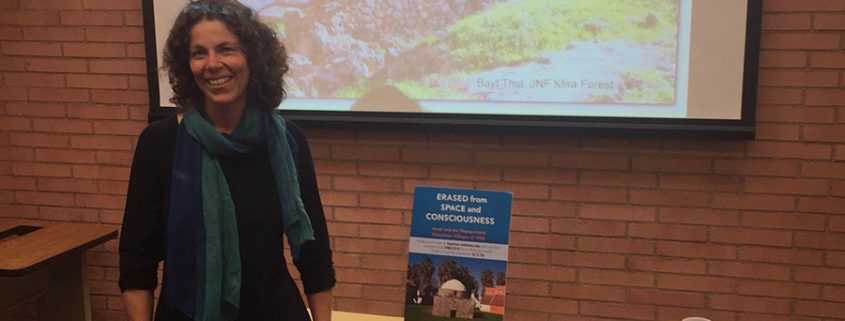Researcher, writer speaks on Palestine-Israeli conflict
The Middle East Studies program at the USC Dornsife College of Letters, Arts and Sciences hosted a discussion called “Palestine in Ruins: The Nakba and Erasure of Memory” on Wednesday at the Von KleinSmid Center, which featured researcher and writer Noga Kadman.
Originally from Jerusalem, Kadman began her involvement in human rights organizations, at age 25 focusing on the Israeli-Palestinian conflict.
“Through this work, I became curious, and wanted to learn the roots of the conflict,” Kadman said.
Kadman focuses on human rights in present-day Israel in her recently published book, Erased from Space and Consciousness: Israel and the Depopulated Palestinian Villages of 1948. She shared her extensive research on the more than 400 depopulated Palestinian villages owing to a 1948 conflict between Palestine and Israel.
“I wanted to understand where those people came from,” Kadman said.
She depicts the effects of the conflict between Israel and Palestine, which escalated into a full-scale war in 1947.
“There was a demographic shift in population of the country, from a predominantly Palestinian country to a predominantly Jewish country … some 750,000 people [refugees] had to flee their houses mostly due to military attacks against their communities […]” Kadman said.
She focuses her research on the demolished villages and the success of the Israeli state in erasing any remembrance of Palestinian history.
“All the land, houses, everything that was in the houses, everything else, became Israel state property,” Kadman said.
More specifically, she lauds Kibbutz Sasa, an Israeli community that continued housing a mosque which survived despite extreme pressure from the Israeli army to be demolished.
“But I found only one community that dealt a lot with what I saw as contradiction to their ideology and the reality of living in a depopulated village … and it is Kibbutz Sasa, the houses and villages of Sa’sa’, just near the border of Lebanon,” Kadman said.
Through her exploration, Kadman found that the education in Israel and Palestine was unequal. Kadman attested to the controversy between the ideologies of many citizens of Israel and Palestine and their need to place blame on historical decisions made by leaders before them.
Those involved with coordinating the event praised Kadman’s ability to reveal topics with undeniable historical relevance. Students and faculty alike expressed their interest in working alongside professionals in research.
“We always like to bring people actively researching on these topics,” said Camillia Shofani, the program assistant for the Middle East Studies program.
Kadman said that solving the conflict requires redefining the understanding of Palestinian involvement, which is not explicitly stated in educational textbooks or governmental sites, such as the Jewish National Fund.
“If we want to think about solving the conflict, I believe that the first step is looking with open eyes at what happened in 1948 and to take responsibility for our part,” Kadman said.
By exposing the information and its significance, Kadman hopes to alter Israeli discourse on the Palestinians, better unify relations between the two countries and help inspire an informed, joint future.
Correction: A previous version of this article stated that the event was titled “Palestine in Ruins: The Erasure of Memory.” It was “Palestine in Ruins: The Nakba and Erasure of Memory.” The article also referred to the Jewish National Forest. It is the Jewish National Fund. The Daily Trojan regrets the errors.


Thank you for this. I would hope that the Shoah Foundation would add the stories of the victims of the Nakba to their Visual History Archives while there’s still time.